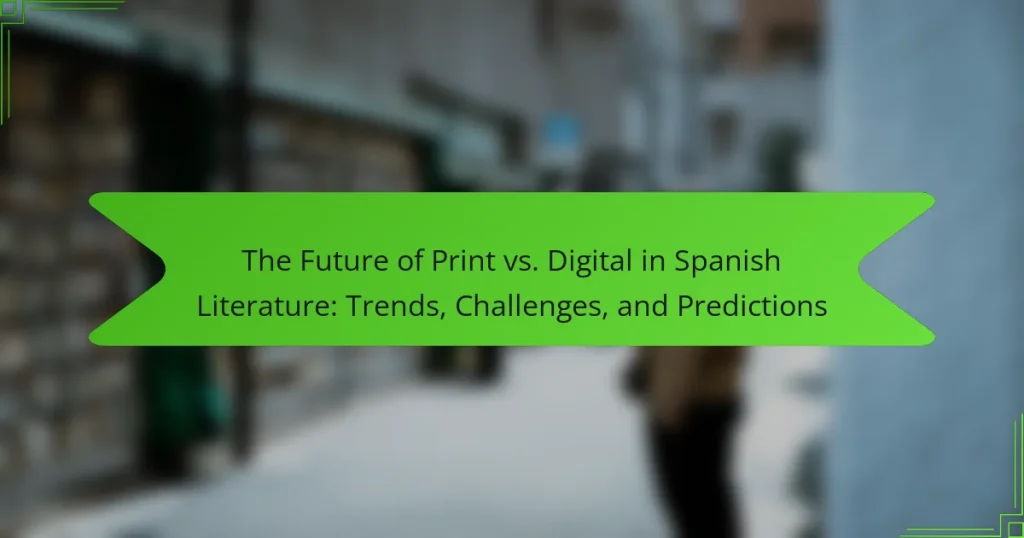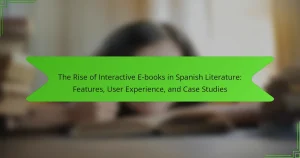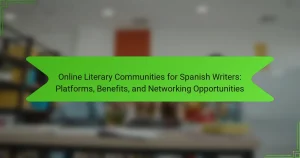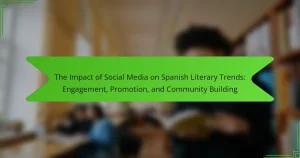The future of Spanish literature faces a pivotal shift as digital formats gain traction. This article explores trends in digital accessibility, challenges for publishers, and the unique attributes of successful digital works. It also examines the potential for hybrid models that blend print and digital elements, addressing evolving reader preferences and the cultural significance of print. Finally, predictions for the coexistence of both mediums highlight the ongoing evolution of this literary landscape.
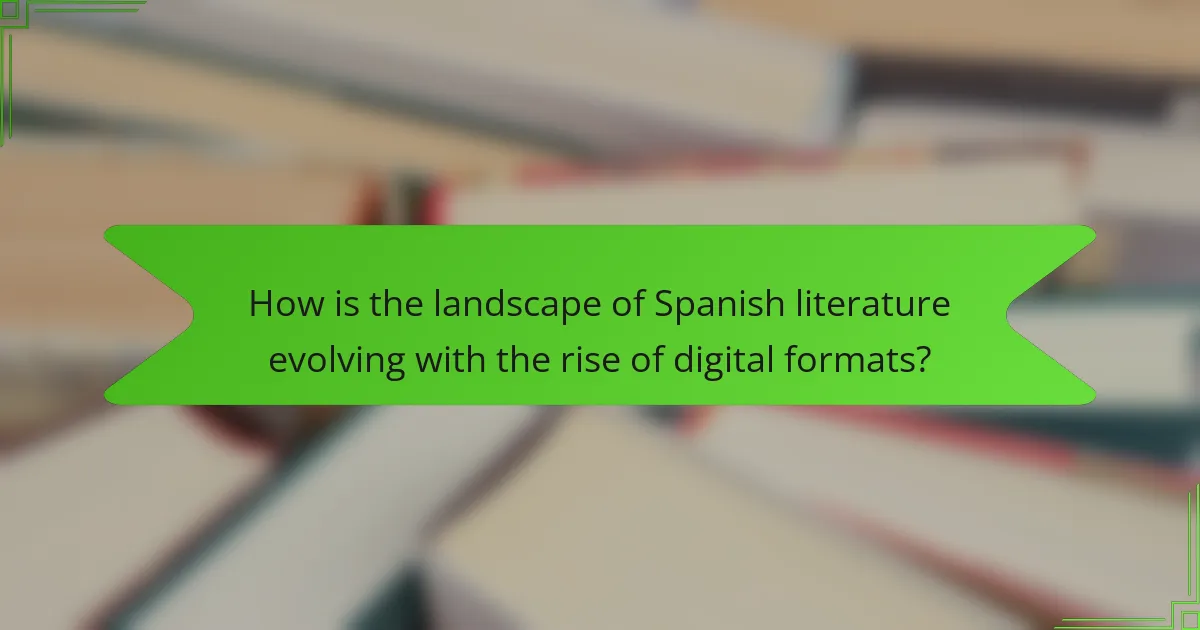
How is the landscape of Spanish literature evolving with the rise of digital formats?
The landscape of Spanish literature is increasingly embracing digital formats, reshaping its future. Digital platforms provide wider accessibility and new opportunities for authors. E-books and audiobooks have gained popularity, allowing diverse voices to reach broader audiences. As a result, traditional print may face challenges in retaining its market share. Unique attributes of digital literature include interactive storytelling and multimedia integration, enhancing reader engagement. Predictions indicate a hybrid model, where print and digital coexist, catering to varied reader preferences.
What trends are shaping the future of print and digital literature in Spanish-speaking countries?
Digital literature is increasingly shaping the future of Spanish literature, driven by technological advancements and changing reader preferences. E-books and audiobooks are gaining popularity, offering convenience and accessibility.
The rise of self-publishing platforms empowers authors to reach wider audiences without traditional publishing barriers. Additionally, social media and online communities foster reader engagement and promote literary discussions.
However, challenges remain, such as the need for digital literacy and concerns over copyright issues. Predictions indicate a hybrid model will emerge, blending print and digital formats to cater to diverse reader preferences.
The unique attribute of this trend is the growing acceptance of digital formats among older generations, expanding the market for digital literature in Spanish-speaking countries.
How do reader preferences differ between print and digital formats in various regions?
Reader preferences between print and digital formats vary significantly across regions. In Spain, print remains popular due to cultural ties and nostalgia, while digital formats are gaining traction among younger audiences. Latin America shows a mixed trend; urban areas favor digital for convenience, whereas rural regions still rely on print. Accessibility and cost also influence preferences, with digital often seen as more affordable. Additionally, the availability of e-books and audiobooks is reshaping consumption habits, making digital formats more appealing.
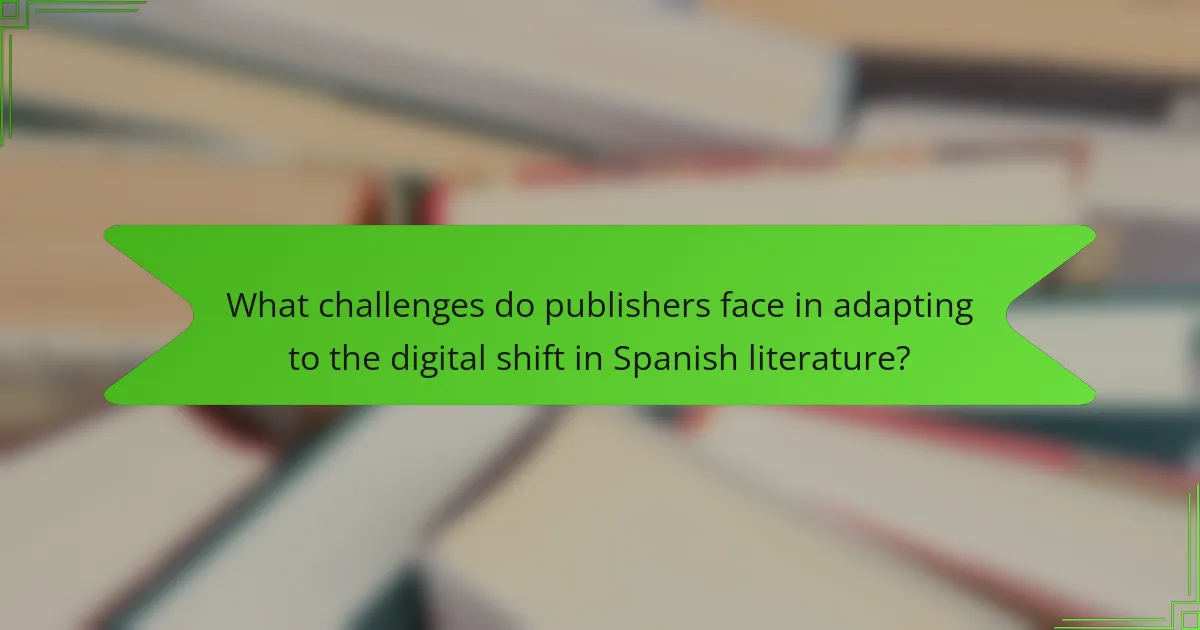
What challenges do publishers face in adapting to the digital shift in Spanish literature?
Publishers face significant challenges in adapting to the digital shift in Spanish literature. Key issues include revenue loss from print sales, the need for digital literacy, and competition from self-publishing platforms. Additionally, they must navigate the evolving reader preferences that favor instant access to content. These factors complicate the transition to a digital-first approach while maintaining quality and cultural relevance.
Which economic factors impact the transition from print to digital in the Spanish literary market?
Economic factors significantly influence the shift from print to digital in the Spanish literary market. The rising costs of print production, distribution, and retailing drive publishers to adopt digital formats. Additionally, changing consumer preferences favor the convenience of e-books and online access. Market trends indicate a growing demand for digital content, as evidenced by increased sales in the e-book sector. Economic constraints faced by consumers also lead to a preference for affordable digital options over traditional print books.
How does accessibility influence the adoption of digital literature among Spanish-speaking readers?
Accessibility significantly enhances the adoption of digital literature among Spanish-speaking readers. It allows for wider reach, enabling readers with varying abilities to engage with texts. Features like adjustable font sizes and audio options cater to diverse needs, promoting inclusivity. As a result, digital platforms can attract a broader audience, fostering a vibrant literary community.
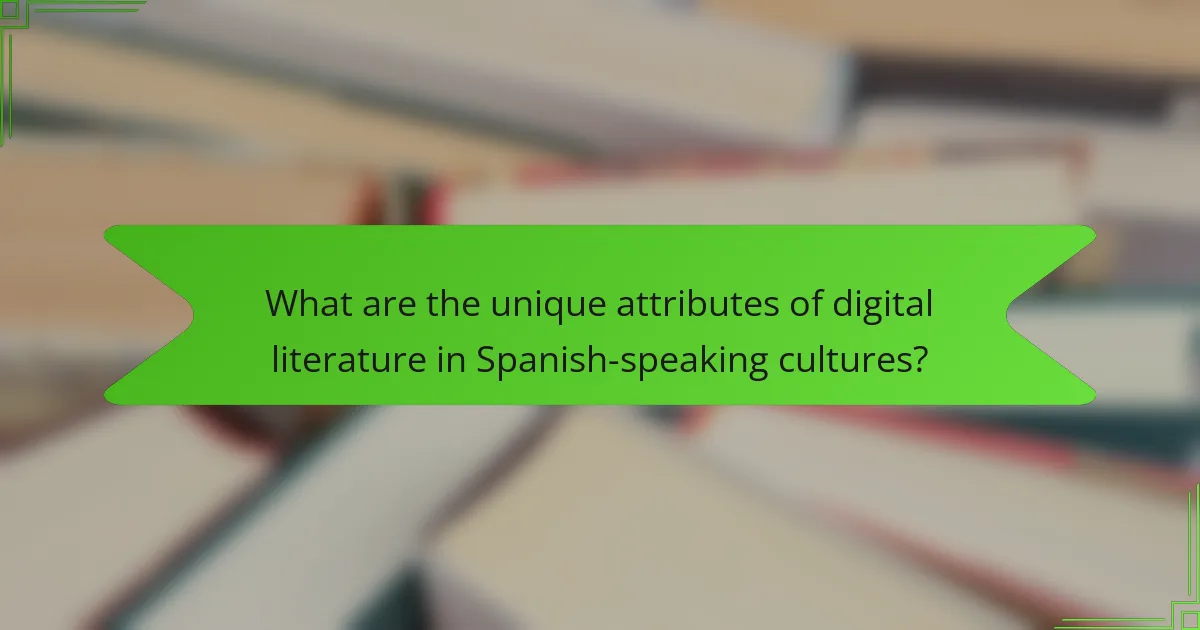
What are the unique attributes of digital literature in Spanish-speaking cultures?
Digital literature in Spanish-speaking cultures is characterized by accessibility, interactivity, and multimedia integration. These unique attributes enhance reader engagement and broaden audience reach. Digital platforms allow for diverse formats such as e-books, blogs, and social media storytelling, which cater to varying preferences. Additionally, the integration of audiovisual elements enriches narratives, creating immersive experiences. As a result, digital literature is reshaping traditional literary landscapes, fostering innovation and collaboration among authors.
How do digital platforms enhance the distribution of Spanish literature?
Digital platforms significantly enhance the distribution of Spanish literature by increasing accessibility and reach. These platforms allow authors to publish works without traditional barriers, promoting diverse voices. E-books and online retailers expand market access, while social media facilitates reader engagement and community building. As a result, more readers can discover Spanish literature globally, fostering a richer cultural exchange.
What role do social media and online communities play in promoting Spanish digital authors?
Social media and online communities significantly enhance the visibility of Spanish digital authors. These platforms facilitate direct engagement between authors and readers, fostering a supportive environment that promotes literary works.
Social media allows authors to share their writing, receive immediate feedback, and build a fanbase. Online communities, such as forums and book clubs, create spaces for discussions, recommendations, and collaborative projects.
As a result, Spanish digital authors can reach wider audiences, increasing their chances of success in a competitive market. This trend highlights the evolving landscape of literature, where digital presence is crucial for recognition and growth.
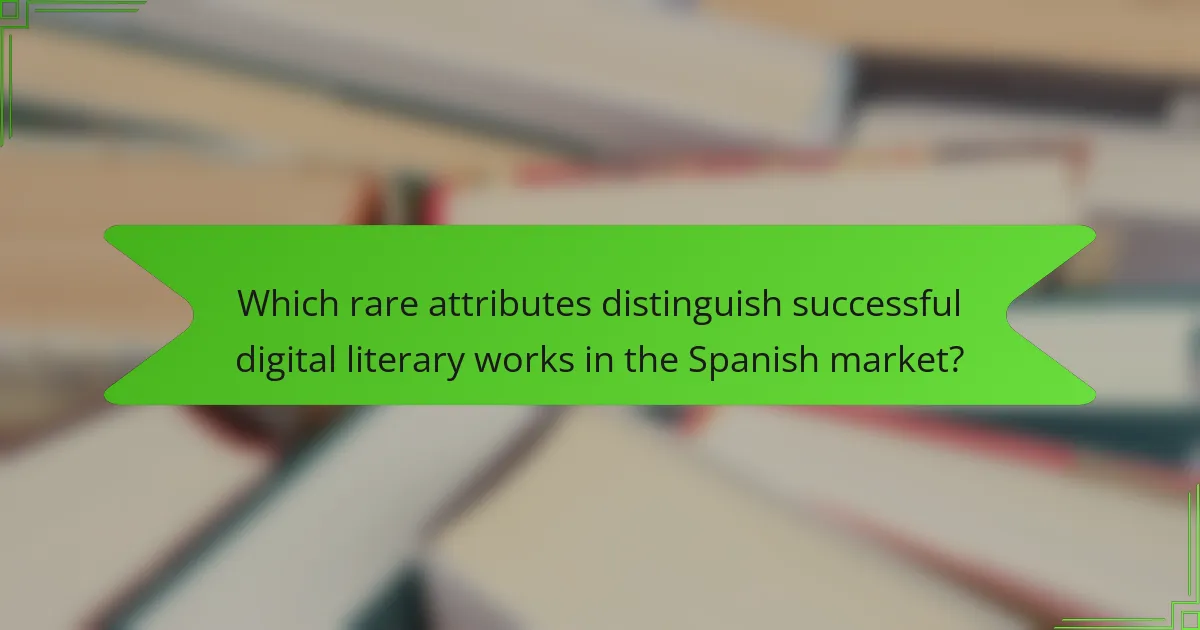
Which rare attributes distinguish successful digital literary works in the Spanish market?
Successful digital literary works in the Spanish market are distinguished by unique attributes such as innovative narrative structures, interactive elements, and audience engagement strategies. These attributes enhance reader experience and differentiate works in a competitive landscape. Digital formats allow for multimedia integration, fostering creativity and attracting diverse audiences. Additionally, successful works often leverage social media for promotion, creating community around the content. These rare traits contribute to their success and reflect evolving trends in Spanish literature.
How do innovative storytelling techniques in digital formats appeal to contemporary audiences?
Innovative storytelling techniques in digital formats engage contemporary audiences by offering immersive experiences that traditional print cannot match. These techniques, such as interactive narratives and multimedia integration, create emotional connections and enhance user engagement. Digital platforms enable real-time feedback and community interaction, further appealing to modern readers. As a result, these methods foster a dynamic relationship between the storyteller and the audience, shaping the future of literature.
What impact do multimedia elements have on the consumption of Spanish literature?
Multimedia elements significantly enhance the consumption of Spanish literature by making it more engaging and accessible. They provide diverse formats such as audio, video, and interactive content, which cater to different learning styles and preferences. For instance, audiobooks allow listeners to experience literature in a new way, while video adaptations can bring stories to life visually. These elements also facilitate deeper connections with the material, encouraging discussions and community engagement. As a result, the integration of multimedia in Spanish literature can bridge generational gaps and attract a broader audience, ultimately shaping its future in both print and digital mediums.
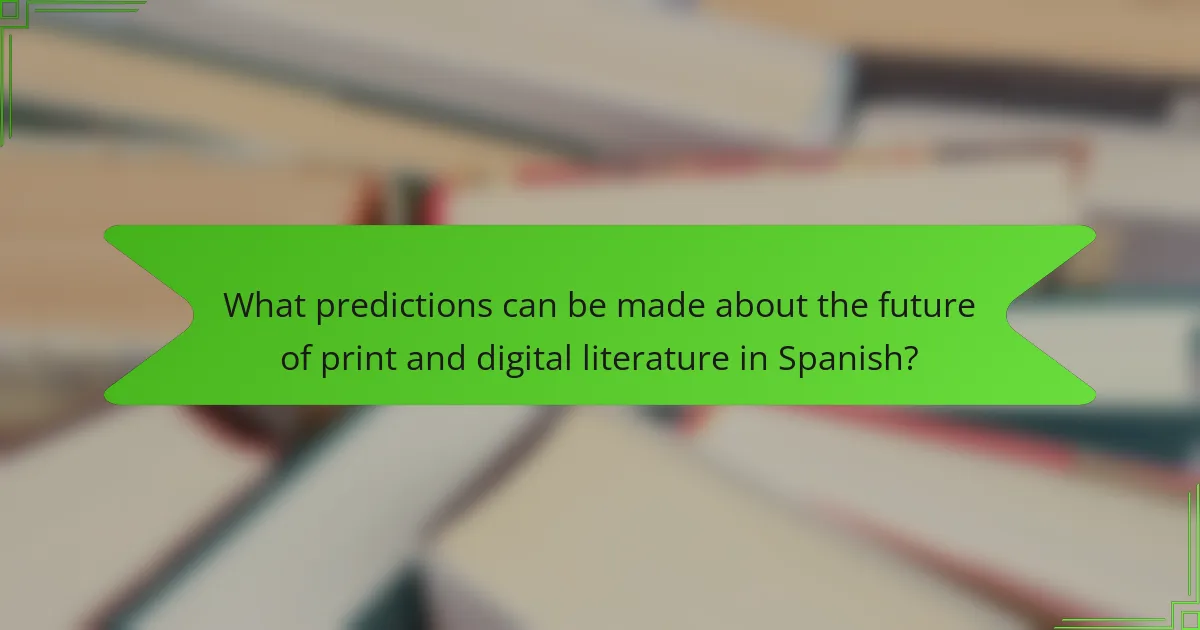
What predictions can be made about the future of print and digital literature in Spanish?
The future of print and digital literature in Spanish will likely see a balanced coexistence, driven by evolving reader preferences and technological advancements. Digital formats are gaining prominence due to accessibility and interactivity, while print retains appeal for its tactile experience and aesthetic value.
Predictions indicate a rise in hybrid models, combining print and digital elements to enhance reader engagement. For instance, augmented reality features in print books may provide immersive experiences, bridging the gap between the two mediums.
Challenges include the need for publishers to adapt to changing consumption habits and the potential decline of traditional bookstores. However, the unique cultural significance of print literature in Spanish-speaking communities may sustain its relevance.
Overall, the landscape of Spanish literature will continue to evolve, reflecting broader trends in technology and consumer behavior while maintaining a rich literary tradition.
How might technological advancements shape the next generation of Spanish literature?
Technological advancements will significantly influence the future of Spanish literature by enhancing digital platforms. Digital formats allow for interactive storytelling, reaching wider audiences and encouraging diverse voices. As a result, traditional print may face challenges in relevance, yet it retains unique attributes like tactile experience and aesthetic value. Predictions indicate a hybrid model where both print and digital coexist, catering to varied reader preferences.
What strategies can authors and publishers employ to thrive in a hybrid literary environment?
Authors and publishers can thrive in a hybrid literary environment by embracing both print and digital formats. They should leverage digital marketing strategies to reach wider audiences, utilize data analytics for reader preferences, and create interactive content to engage readers. Additionally, fostering community through social media and hosting virtual events can enhance visibility and connection. Collaboration with influencers and other authors can further amplify reach and credibility. Adapting to changing consumer behaviors and preferences is essential for success in this evolving landscape.
What best practices should be considered when transitioning from print to digital formats in Spanish literature?
Transitioning from print to digital formats in Spanish literature requires careful consideration of several best practices. First, prioritize user experience by ensuring that digital texts are easily navigable and accessible across devices. Second, leverage multimedia elements to enhance storytelling, such as audio, video, or interactive content, which can engage readers more effectively. Third, maintain the integrity of the original text while adapting for digital formats, ensuring that cultural nuances and literary styles are preserved. Additionally, consider the use of analytics to understand reader preferences and behaviors, allowing for tailored content delivery. Finally, foster community engagement through social media and online platforms, creating a space for discussion and feedback.
